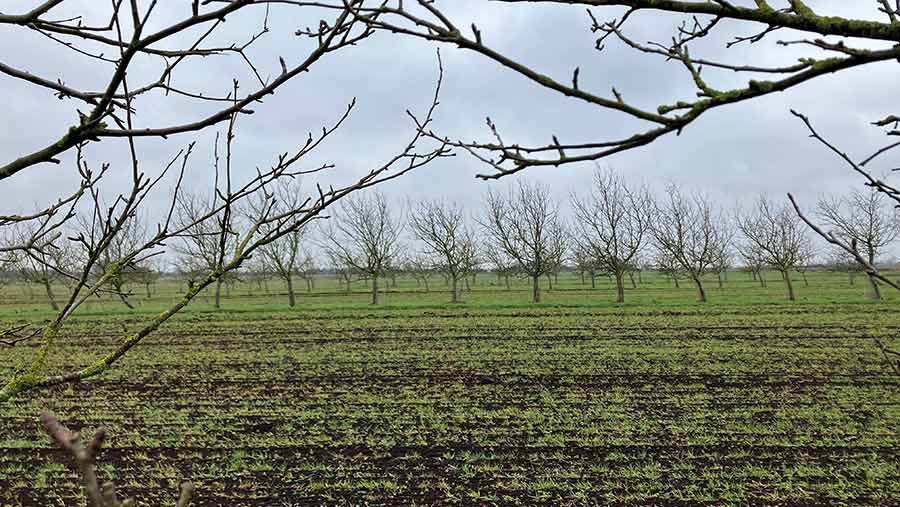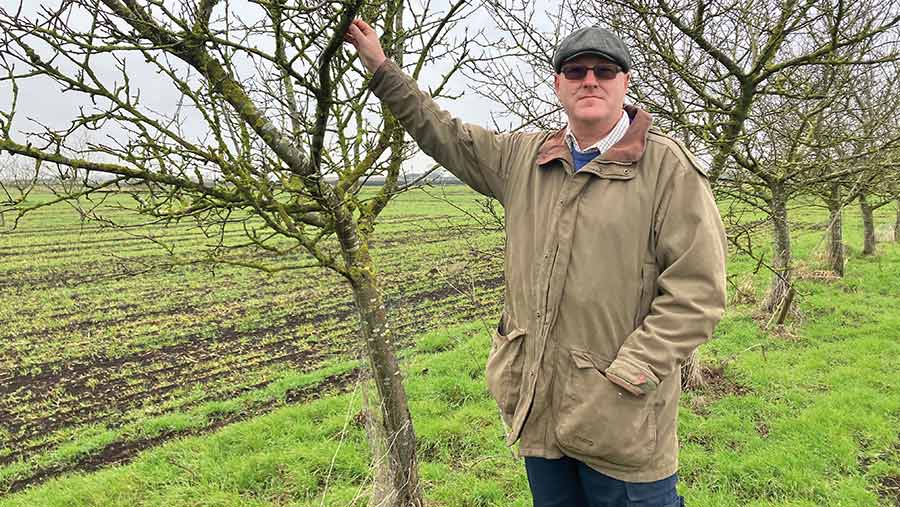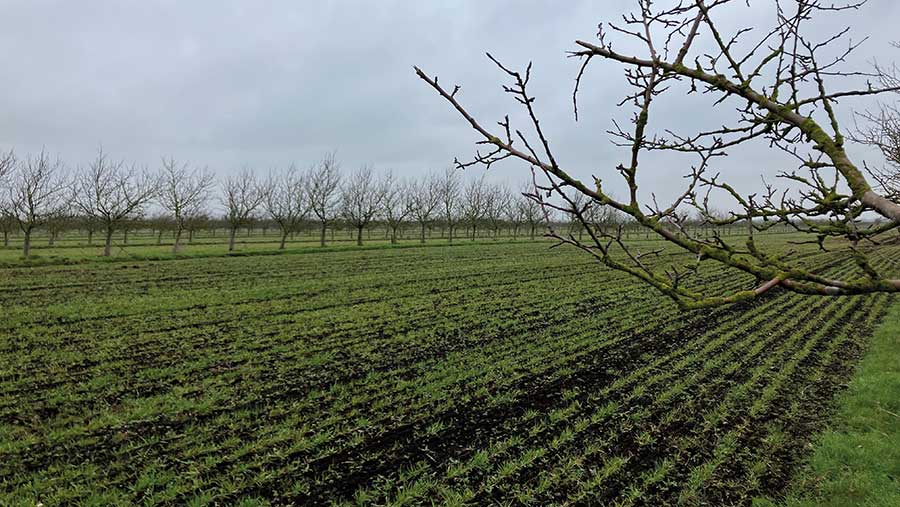Video: UK’s largest agroforestry system integrates fruit and arable
 © MAG/Emma Gillbard
© MAG/Emma Gillbard First-generation tenant farmer Stephen Briggs planted the UK’s largest agroforestry system, integrating fruit trees and arable cropping to boost land productivity.
More than a decade after the 4,500 apple trees were planted at Whitehall Farm in Cambridgeshire, Mr Briggs continues to reap the economic and environmental benefits.
“By growing fruit trees and cereal crops together, we are farming in a three-dimensional way to deliver lots of benefits in terms of enterprises stacking, economic returns and improved biodiversity,” he says.
See also: The benefits of integrating trees into arable land
Harvesting more sunlight
The 52ha site is made up of 13 varieties of apple trees planted in 24m alleys. A 6m controlled-traffic farming system is in place to minimise soil compaction across the arable area.
The design has lifted land use efficiency by 25% as a result of harvesting more sunlight throughout the year.
“From July to September, when sunlight is at its maximum, cereal crops have finished senescence and are no longer photosynthesising.
“During this time the trees are able to photosynthesise, so we are making better use of sunlight.”
Despite Mr Briggs’ assumption that there would be a cereal yield penalty for crops planted closest to the tree boundary due to shading and competition, the opposite was true.
“Crop yields were, in fact, higher closer to the trees – so much so that we had to tilt the combine header at harvest,” he says.
He believes the deep-rooting trees improved soil drainage and moisture retention, while the addition of leaf litter matter boosted organic matter levels.
Mycorrhizal fungi interactions from tree roots drawing phosphates from deep in the ground are also thought to play a beneficial role.
Why agroforestry?
When Mr Briggs and his wife took on the Cambridgeshire County Council tenancy in 2007, he recalls their only farm equipment was “a box of spanners and a ride-on lawn mower”.
The land had been left “tired” after 40 years of growing intensive wheat, oilseed rape, sugar beet and potato crops, which meant soil rejuvenation was a key priority.
With an aim of minimising capital outlay, optimising markets and a background in consultancy, transitioning the farm into organic status seemed a logical step.

Stephen Briggs © MAG/Emma Gillbard
Organic cereals and vegetable crops were grown across the 100ha farm, but with costs and rents rising, something else needed to change.
Mr Briggs previously worked overseas and had experience in agroforestry, following a Nuffield scholarship on the subject.
Limited room for agricultural expansion and a change to the Common Agricultural Policy that made fruit trees an eligible land use for the Basic Payment Scheme got him thinking.
He designed and planted the organic agroforestry system in 2009-10, with the aim of farming upwards to maximise land use.
Varieties included Bramley, Herefordshire Russet and Adams Pearmain.
Despite a few establishment challenges, including an influx of pigeons damaging a few young fruit trees, the agroforestry system has been a worthy farm addition.

© MAG/Emma Gillbard
The benefits
The trees act as natural shelterbelts in an otherwise exposed area of fenland prone to soil erosion.
Trees mitigate the effects of extreme weather and create a beneficial microclimate for cereal crops, reducing evapotranspiration to help increase water use efficiency.
Out of the 100ha farm, 52ha is in agroforestry, while the remaining area is used for conventional arable production.
Although there is little yield difference between the two systems, during times of weather extremes the agroforestry system reveals a clear benefit.
“During 2019, we had a very hot, dry summer, and a freak storm with 60mph winds damaged our oat crops.
“The oats between the trees were protected from the wind, losing just 10% of grain yield, but the conventional arable area saw a 20% yield loss.”
The rule of thumb is for every 1m of tree height, wind speed is reduced by 10%.
Diversified income
Fruit trees also bring a diversified income and provide an opportunity to capture added value in the local marketplace.
With little organic fruit grown in the UK, there was opportunity to sell locally.
In 2018, Mr Briggs decided to make the most of the 25,000 cars passing the farm each day and converted a grain store into a shop and café to sell the bottled juice.
Furthermore, by mixing perennial and annual crops, he created a more resilient business by reducing the risk of establishing crops each season.
“We also find crop yields compensate one another. Sometimes, when we have good cereal yields, the fruit trees do not perform so well and when the fruit trees are more productive, the cereals are not.”
What’s more, intercropping reduces pest and disease pressure for both crops, which is particularly important in an organic system.
“We could have planted the trees across a full 1ha orchard, but this would be another monoculture with greater disease pressure.”
Greater biodiversity
Since planting the trees, beneficial insect numbers have increased 400%, with a greater number of pollinator species evenly spread across the fields.
“It is certainly delivering on biodiversity benefits. The trees are essentially 3D beetle banks which provide biodiversity benefits, but also produce food and an income.”
A Mid-Tier Countryside Stewardship agreement is in place, with a pollen and nectar mix planted beneath the trees to stack funding options.
Mr Briggs says agroforestry only takes up 8% of arable land on the farm, but it has created a wide range of benefits.
Niche crop oats suffers from frost heave
Looking for further ways to maximise income and make the most of niche markets, Cambridgeshire tenant farmer Stephen Briggs decided to grow oats certified as organic and gluten-free for the Swiss export market.
Organic wheat, barley and vegetables were grown between the rows of apple trees, but after searching for simpler and more profitable crops, Mr Briggs delved into the oat market.
In some fields, he has successfully grown continuous oats with a companion clover crop for seven years, with average yields of 5-6.5t/ha.
However, this season crops have taken the brunt of heavy, prolonged frosts and suffered from frost heave.
“As a result of greater soil organic matter levels, the soil is able to hold and retain more water.
“The only downside to this is that during cold winter temperatures, the soils froze hard and the young shoots were damaged as the soil expanded.”

